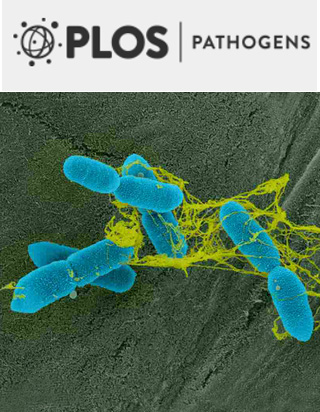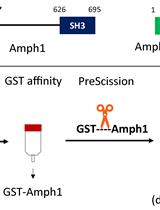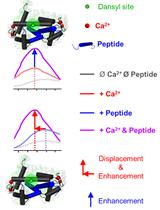- EN - English
- CN - 中文
Tandem Affinity Purification of SBP-CBP-tagged Type Three Secretion System Effectors
SBP-CBP-tagged三型分泌系统效应因子的串联亲和纯化
发布: 2019年06月20日第9卷第12期 DOI: 10.21769/BioProtoc.3277 浏览次数: 4878
评审: Ralph Thomas BoettcherYing FengAnonymous reviewer(s)
Abstract
Identification of protein-protein interactions of bacterial effectors and cellular targets during infection is at the core to understand how bacteria manipulate the infected host to overcome the immune response. Potential interacting proteins might be identified by genetic methods, i.e., two hybrid screens and could be verified by co-immunoprecipitation. The tandem affinity purification (TAP) method allows an unbiased screen of potential interaction partners of bacterial effectors in a physiological approach: target cells can be infected with a bacterial strain harboring the TAP-tagged bacterial effector protein which is translocated in the host similar as under physiological infection conditions. No transfection and overexpression of the bacterial protein in the eukaryotic host are needed. Therefore, also host target cells not easy to transfect can be analyzed by this method. Moreover, the two consecutive affinity tags Calmodulin-Binding-Peptide (CBP) and Streptavidin-Binding-Peptide (SBP) fused to the translocated bacterial protein allow an outstanding clear purification of protein complexes formed between the bacterial protein of interest and host cell proteins with less occurrence of contaminants. Mass spectrometry allows an unbiased identification of interacting eukaryotic proteins.
Keywords: Yersinia (耶尔森菌)Background
The interaction of bacterial effectors with eukaryotic proteins during infection is fundamental to understand the processes initiated by the bacteria to manipulate the host cell responses in order to establish infection. The type three secretion system (TTSS) is a needle-like structure found in several gram-negative bacteria that facilities direct secretion of bacterial effector proteins into the host cell. The tandem affinity purification (TAP) of TAP-tagged bacterial effector proteins secreted directly into the host cell via the TTSS provides the invaluable possibility to identify eukaryotic proteins interacting with bacterial effector proteins in a physiological approach. No transfection and overexpression of the bacterial protein in the eukaryotic host is needed once the tandem affinity tag labeled bacterial protein is translocated in the host cell cytoplasm during infection with the manipulated bacteria. The use of two affinity tags increases the specificity of the protein-protein interaction and ensures a low level background of nonspecific interactions.
This method can be adapted to a wide range of gram-positive or gram-negative bacterial species and various host target cell types. We have utilized this assay to identify new interaction partners of the Yersinia effector protein YopM. In an approach with TAP-tagged YopM being translocated into the macrophage cell line J774A.1 via the natural type three secretion system of Yersinia we verified the interaction of YopM with host kinases PKN2 and RSK1. Moreover, we detected association with additional PKN and RSK isoforms and identified a new interaction partner of YopM, the DEAD box Helicase DDX3. This assay can be adapted to other bacterial species and host cell types.
Materials and Reagents
- Pipette tips (sarstedt, catalog numbers: 70762010 [1,000 μl]; 70762012 [100 μl] and 701116 [10 μl])
- Cell culture dishes 100 mm (sarstedt, catalog number: 83.3902)
- Falcon tubes 15 ml (Sarstedt, catalog number: 62.544.502)
- Micro tubes 1.5 ml (Sarstedt, catalog number: 72.690.001)
- Cell scraper (Sarstedt, catalog number: 83.1830)
- J774A.1 cells (ATCC# TIB-67)
- Yersinia enterocolitica strain deltaYopM (Yersinia enterocolitica Serotype O:8 strain WA-314 with the YopM gene replaced by a kanamycin resistance cassette Trulzsch et al., 2004)
- Yersinia enterocolitica strain deltaYopM(pYopM-CBP-SBP) (deltaYopM strain complemented with the DNA construct YopM-CBP-SBP in pACYC184; Hentschke et al., 2010)
- RPMI1640 (Gibco, catalog number: 61870-010)
- Fetal bovine serum (FCS, Gibco, catalog number: 26140-079)
- Penicillin-Streptomycin (Gibco, catalog number: 15140122)
- L-Glutamine (Gibco, catalog number: A2916801)
- pACYC184 vector (NEB; Hentschke et al., 2010)
- InterPlay Mammalian TAP System (Agilent, catalog number: 240103)
- Bromphenol Blue (Serva, catalog number: 15375.02)
- Coomassie brilliant blue (Merck, catalog number: 1154440025)
- Calmodulin Sepharose 4B (GE Healthcare, Life, catalog number: 17052901)
- Streptavidin Sepharose High Performance (GE Healthcare, Life, catalog number: 17511301)
- Complete Protease inhibitor (Roche Diagnostics)
- Methanol (Roth, catalog number: 8388.1)
- Trypsin, sequencing grade modified (Promega, catalog number: V5111)
- a-SBP antibody (Millipore, clone 20, catalog number: MAB10764)
- Luria-Bertani broth (Roth, catalog number: X986.2)
- Acetic acid (Roth, catalog number: T179)
- SDS (Roth, catalog number: CN30.3)
- Molecular weight marker (Molecular weight range 10-180 kDa; PageRuler Prestained Protein Ladder, Thermo Scientific, catalog number 26616)
- Glycerol (Calbiochem, catalog number: 356350)
- β-Mercaptoethanol (Sigma, catalog number: M3148-25ml)
- Tris (Sigma, catalog number: T1503-1KG)
- EDTA (Roth, catalog number: 80432)
- Dithiothreitol (DTT; Roth, catalog number: 6908.2 259)
- Iodacetamid (Sigma, catalog number: I6125-25g)
- NH4HCO3 (Sigma, catalog number: 09830)
- Acetonitrile (Thermo, catalog number: 51101)
- Formic acid (Fluka, catalog number: 94318)
- Trifluor acetic acid (TFA; Roth, catalog number: CN30.3)
- Coomassie Brilliant Blue R-250 (Serva, catalog number: 17524.01)
- Bromphenol blue (Merck, catalog number: 8122)
- NaCl (Roth, catalog number: 9265.1)
- KCl (Merck, catalog number: 1049361000)
- Coomassie staining solution (see Recipes)
- Coomassie destain solution (see Recipes)
- SDS-PAGE sample buffer (2x) (see Recipes)
- PBS (10x) (see Recipes)
Equipment
- Pipettes (Eppendorf, Eppendorf Research Plus, catalog number: 3123000900)
- Power supplies (Bio-Rad, Bio-Rad power PC 200)
- SDS-PAGE electrophoresis cell (Bio-Rad Mini-Protean II)
- Cell counting chamber (Hartenstein, Neubauer-cell counting chamber)
- Mammalian cell culture incubator (Binder, CB Series)
- Shaking incubator (Sartorius, model Certomat BS-1)
- Rotary mixer (Hartenstein, catalog number LD26/L263)
- Centrifuge (Eppendorf, model: 5417R)
- Vacuum dryer (Speed Vac SC110, Savant)
- MALDI-TOF mass spectrometer (Bruker Daltonics, REFLEX IV)
Procedure
文章信息
版权信息
© 2019 The Authors; exclusive licensee Bio-protocol LLC.
如何引用
Berneking, L., Schnapp, M., Nauth, T. and Hentschke, M. (2019). Tandem Affinity Purification of SBP-CBP-tagged Type Three Secretion System Effectors. Bio-protocol 9(12): e3277. DOI: 10.21769/BioProtoc.3277.
分类
细胞生物学 > 细胞信号传导 > 胞内信号传导
分子生物学 > 蛋白质 > 蛋白质-蛋白质相互作用
您对这篇实验方法有问题吗?
在此处发布您的问题,我们将邀请本文作者来回答。同时,我们会将您的问题发布到Bio-protocol Exchange,以便寻求社区成员的帮助。
提问指南
+ 问题描述
写下详细的问题描述,包括所有有助于他人回答您问题的信息(例如实验过程、条件和相关图像等)。
Share
Bluesky
X
Copy link












